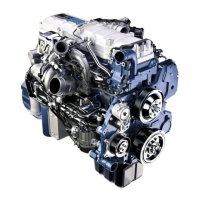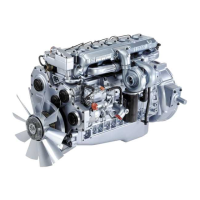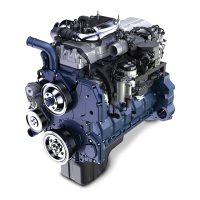SECTION 4 – ENGINE OPERATION
Operation
SUGGESTED WARM UP TIME
NOTE:
Before applying a load or increasing speed above 1000
rpm, warm up engine for a minimum of 5 minutes at or below
1000 rpm. T he warm up period a llo ws lubricating o il to establish
a film between moving parts.
After allowing the engine to warm up for 5 minutes, begin
operating the vehicle at reduced engine speeds and load until it
reaches operating temperature. Once operating temperature is
reached, begin normal operation. The Cold Ambient Protection
(CAP) system aids in engine warm up and maintains engine heat
during extended idling periods. See Cold Ambient Protection
(CAP) (page 55).
IDLE SPEED
WARNING: To prevent personal injury or death,
provide ventilation when operating an engine in a closed
area. Inhalation of exhaust gas can be fatal.
Low idle speed for the MaxxForce® DT, 9, and 10 Diesel Engines
is 700 rpm (nonadjustable). If the engine coolant temperature
is below 70 °C (158 °F), the Engine Control Module (ECM) will
adjust the low idle speed from 700 rpm to a maximum of 875
rpm. High idle speed is a nonadjustable factory setting.
High idle speed is a nonadjustable factory setting. The high idle
setting depends on the application of the engine and has the
following ranges:
MaxxForce® DT: 2600 rpm through 2770 rpm
MaxxForce® 9 and 10: 2325 rpm through 2425 rpm
EXTENDED IDLING PERIODS
CAUTION:
To prevent engine damage, do not extend low idle
periods.
Idling periods over 15 minutes should be avoided. Diesel engine
efficiency is improved when the cylinder temperature remains
high. Low temperature in cylinders may cause the following:
• Unburned fuel may seep from exhaust manifold gaskets and
vehicle exhaust system connections. This seepage has the
dark colored appearance of lubricating oil.
• Incomplete combustion and unburned fuel washes
lubricating oil from cylinder sleeves. Unburned fuel will
be carried into th e lubricating oil, dilute the oil, and change
oil viscosity.
• Carbon forms on internal components of turbochargers
and Exhaust Gas Recirculation (EGR), reducing engine
efficiency.
• Carbon clogs and damages the Diesel Particulate Filter
(DPF).
Form No. 1172040R1
Printed in the United States of America Page 51
